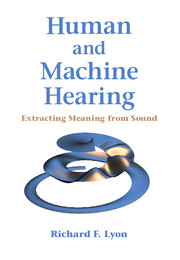Book contents
- Frontmatter
- Dedication
- Contents
- Foreword
- Preface
- Part I Sound Analysis and Representation Overview
- Part II Systems Theory for Hearing
- 6 Introduction to Linear Systems
- 7 Discrete-Time and Digital Systems
- 8 Resonators
- 9 Gammatone and Related Filters
- 10 Nonlinear Systems
- 11 Automatic Gain Control
- 12 Waves in Distributed Systems
- Part III The Auditory Periphery
- Part IV The Auditory Nervous System
- Part V Learning and Applications
- Bibliography
- Author Index
- Subject Index
- Plate section
11 - Automatic Gain Control
from Part II - Systems Theory for Hearing
Published online by Cambridge University Press: 28 April 2017
- Frontmatter
- Dedication
- Contents
- Foreword
- Preface
- Part I Sound Analysis and Representation Overview
- Part II Systems Theory for Hearing
- 6 Introduction to Linear Systems
- 7 Discrete-Time and Digital Systems
- 8 Resonators
- 9 Gammatone and Related Filters
- 10 Nonlinear Systems
- 11 Automatic Gain Control
- 12 Waves in Distributed Systems
- Part III The Auditory Periphery
- Part IV The Auditory Nervous System
- Part V Learning and Applications
- Bibliography
- Author Index
- Subject Index
- Plate section
Summary
In recent years, devices for the automatic control of gain have increased in importance in various areas of amplifier technology. One class of such devices is based on the following principle: a portion of the output signal current of a valve amplifier is extracted, amplified and fed to a rectifier; the resulting rectified signal voltage is then used to vary the grid voltage of an amplifier valve. In this manner an increase in output power leads to a reduction in gain.
—“On the Dynamics of Automatic Gain Controllers,” Karl Küpfmüller (1928)I have long viewed the automatic gain control (AGC) function as one of the most important, and tricky, parts of modeling the function of the cochlea (Lyon, 1982, 1990). To understand or design this important level-adaptive function, one must have an appreciation for the dynamics of feedback control, in a highly variable nonlinear context.
In this chapter, I provide the basic background and analysis techniques that our cochlear models will draw on. In particular, I show how the use of output amplitude to control the damping factors of cascaded resonators can be modeled as a robust feedback control system that compresses a wide input dynamic range into a narrower output dynamic range, by examining this approach in the context of a fairly general single-channel AGC formulation.
Input–Output Level Compression
Systems that use feedback from a detected output level to adjust their own parameters to keep the output level from varying too much are called automatic gain control systems. Such systems are inherently nonlinear, with a compressive input–output function: when the input changes by some factor, the output level changes by a factor closer to 1. AGC has long been used and analyzed in wireless communication systems (Wheeler, 1928; Küpfmüller, 1928), including television (De Forest, 1942), and is an idea that has long inspired corresponding models in biological systems, including vision and hearing (Rose, 1948, 1973; Smith and Zwislocki, 1975; Allen, 1979).
- Type
- Chapter
- Information
- Human and Machine HearingExtracting Meaning from Sound, pp. 202 - 218Publisher: Cambridge University PressPrint publication year: 2017



